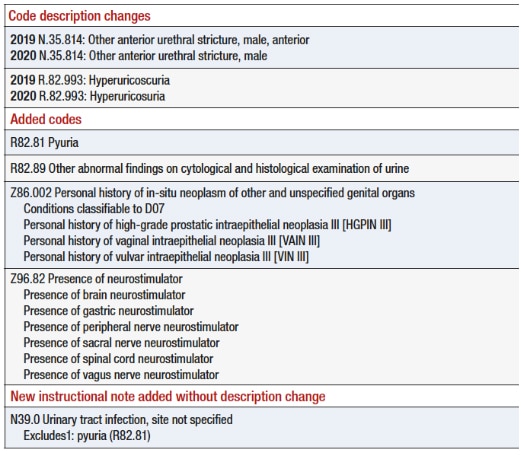Several ICD-10 and CPT code changes came into effect for urology in 2020. Practitioners need to understand the updates and associated urology medical billing guidelines to ensure accurate reporting and timely reimbursement.
- New ICD-10 Codes
Diagnosis codes must always be assigned to the highest known level of specificity. Effective Oct 1, 2019, ICD-10 code changes for primary urologic issues include:
- code description changes
- codes additions, and
- a new instructional note without description change
The following table from a Urology Times article shows the 2020 ICD-10 codes changes for primary urologic concerns:
Source: www.urologytimes.com
CPT Code Changes
- New Series of Category III Codes
CPT codes include Category I codes and Category III (T codes) codes. While Cat I codes are the standard codes used to report services, Cat III codes”) are used to track the utilization of emerging technologies, services, and procedures.
In 2020, a new series of category III codes 0587T-0590T for insertion, replacement, or removal integrated single device neurostimulation system and the analysis and testing came into effect on Jan 1, 2020. The new codes have been added to account for the differences necessary to perform these services(www.community.auanet.org):
- 0582T – Transurethral ablation of malignant prostate tissue by high-energy water vapor thermotherapy, including intraoperative imaging and needle guidance
- 0548T – Transperineal periurethral balloon continence device; bilateral placement, including cystoscopy
- 0549T – Transperineal periurethral balloon continence device; unilateral placement, including cystoscopy
- 0550T– Transperineal periurethral balloon continence device; removal, each balloon
- 0551T – Transperineal periurethral balloon continence device; adjustment of balloon(s), fluid volume
- 05871– Percutaneous implantation or replacement of integrated single device neurostimulation system including electrode array and receiver or pulse generator, including analysis, programming and eimaging guidance when performed, posterior tibial nerve
- 0588T – Revision or removal of integrated single device neurostimulation system including electrode array and receiver or pulse generator, including analysis, programming, and imaging guidance when performed, posterior tibial nerve
- 0589T – Electronic analysis with simple programming of implanted integrated neurostimulation system (eg, electrode array and receiver), including contact group(s), amplitude, pulse width, frequency (Hz), on/off cycling, burst, dose lockout, patient-selectable parameters, responsive neurostimulation, detection algorithms, closed-loop parameters, and passive parameters, when performed by physician or other qualified health care professional, posterior tibial nerve, 1-3 parameters
- 0590T – Electronic analysis with complex programming of implanted integrated neurostimulation system (eg, electrode array and receiver), including contact group(s), amplitude, pulse width, frequency (Hz), on/off cycling, burst, dose lockout, patient-selectable parameters, responsive neurostimulation, detection algorithms, closed-loop parameters, and passive parameters, when performed by physician or other qualified health care professional, posterior tibial nerve, 4 or more parameters
Points to Note
A recent Urology Times article cautions that since Category III codes are a unique subset of the CPT code set, urologists and practices need to understand their value, when to use them, and when they can be used for reimbursement.
- As the code descriptors of the codes include imaging, programming, and analysis a as part of the placement procedure, these services are not separately reported.
- There are separate codes to report electronic analysis with simple (0589T) and complex (0590T) programming. These codes should be used when programming services are performed independent of placement and revision/removal services.
- The exclusionary parenthetical that follows each code and other parentheticals within the Category III section for these codes and in other section of the code set provide guidance regarding the intended use for the new codes.
- New and Deleted Codes for Biofeedback Training
New – Two new time-based codes have been created so as to allow the physician to “most accurately describe and be reimbursed for the amount of time and effort spent face to face with an individual patient” (www.urology.com). The two new time-based biofeedback codes are:
- 90912 Biofeedback training, perineal muscles, anorectal or urethral sphincter, including EMG and/or manometry, when performed; initial 15 minutes of one-on-one physician or other qualified health care professional contact with the patient.
- 90913 . . . each additional 15 minutes of one-on-one physician or other qualified health care professional contact with the patient (List separately in addition to code for primary procedure)
Points to Note:
- Codes 90912 and 90913 include EMG and/or manometry is included, when performed.
- Code 90913 is an add-on code to “describe each additional 15 minutes” of one-on-one physician or other qualified health care professional contact with the patient. Code 90913 must be used in conjunction with code 90912 and cannot be billed alone.
Deleted – The following code has been deleted:
- 90911 Biofeedback training, perineal muscles, anorectal or urethral sphincter, including EMG and/or manometry
Revisions
The 2020 CPT code changes for urology include revisions under urinary system/bladder introduction:
- The parenthetical note following code 51715 (Endoscopic injection of implant material into the submucosal tissues of the urethra and/or bladder neck) has been deleted
- The descriptor of Orchiopexy code 54640 has been revised to:
CPT 54640 – Orchiopexy, inguinal or scrotal approach
Urology practices need to update templates to load the new codes. When it comes to billing Category III codes, they must check payer rules before providing the service to determine how move forward. Medical billing companies that specialize in urology medical billing stay up to date on ICD-10 and CPT code changes. Partnering with a reliable service provider is the best way report the right codes for services rendered.





